Apple trees are an quintessential a part of our lives. They offer us with clean fruit, coloration, and aesthetic enchantment. However, occasionally, apple timber can fall victim to sicknesses that can be dangerous to each the tree and the fruit it produces. As a accountable gardener, it is important to have a great understanding of the maximum common illnesses that affect apple trees and the way to treat them efficaciously. In this blog publish, we are able to take a more in-depth look at some of the maximum commonplace apple tree diseases, their signs, and the only methods to treat them. We will also cowl a few preventative measures that you can take to limit the chances of your apple trees falling ill. Read directly to examine the entirety you need to recognise to hold your apple timber healthful and thriving.
Apple timber are iconic symbols of lush orchards and fruitful harvests. However, those superb timber aren’t proof against diverse sicknesses which could avert their boom and productivity. In this section, we will delve into the advent of common diseases that afflict apple trees, offering you with treasured insights on the way to become aware of and deal with them correctly.
Apple timber can fall sufferer to a number of illnesses because of fungi, bacteria, viruses, and environmental factors. Some diseases are more normal in specific areas or climates, while others can spread hastily throughout unique apple-growing areas. Understanding these diseases and their effect is crucial for apple tree growers to protect their orchards and maximize their yields.
One of the maximum commonplace sicknesses affecting apple bushes is apple scab. It is because of the fungus Venturia inaequalis and manifests as darkish, scaly lesions on leaves, fruit, and even twigs. This sickness can considerably lessen the tree’s usual health and productivity if left untreated.
Another regular disease is powdery mold, caused by diverse fungal species. It seems as a white powdery coating on leaves, shoots, and buds, hindering photosynthesis and weakening the tree’s potential to provide end result.
Fire blight is a bacterial sickness that poses a widespread chance to apple bushes. It spreads hastily, inflicting wilting, blackening, and a scorched appearance on blossoms, shoots, and branches. If not managed directly, fireplace blight can lead to excessive harm, probably killing the entire tree.
Cedar apple rust is a fungal disorder that impacts apple bushes and different participants of the Rosaceae circle of relatives. It manifests as rusty orange or yellow spots on leaves and fruit, inflicting defoliation and decreasing the tree’s power.
These are just a few examples of the illnesses which could afflict apple trees. By familiarizing your self with their symptoms and traits, you could take proactive measures to defend your apple bushes and make sure a bountiful harvest.
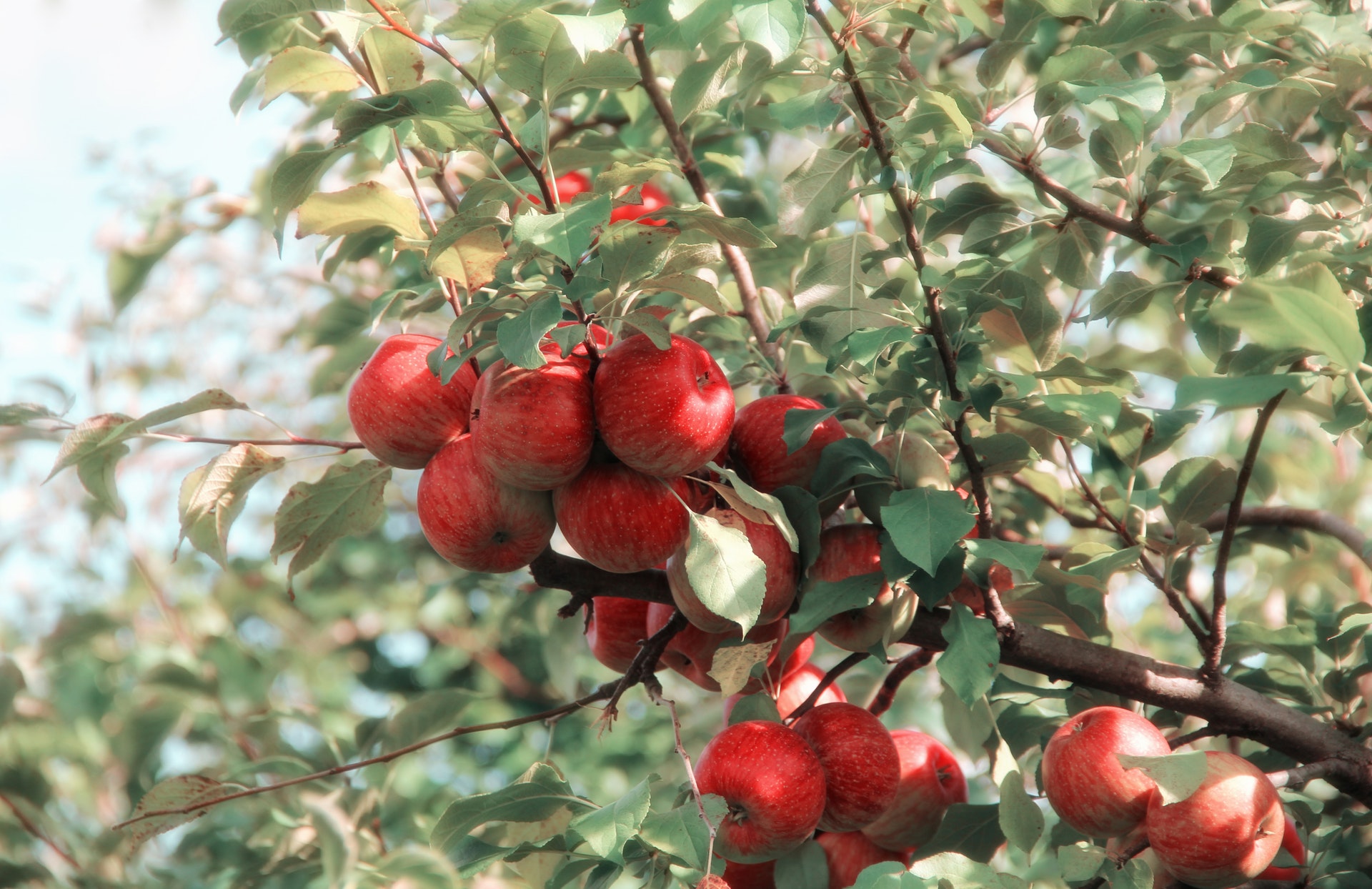

After all the exhausting work, time, and power you’ve spent to produce an considerable apple harvest, don’t lose your fruits to illness. Apple tree illnesses seem continuously and unfold from tree to tree. We’ve pared down frequent apple tree illness info to assist you to uncover the perfect methods to deal with them.
The suitable preventive and therapy measures improve your probabilities of controlling these dangerous illnesses. Some illnesses are extra treatable than others, whereas others don’t have any remedy. Figuring out signs as quickly as potential is necessary to stop additional unfold to wholesome apple timber.
Tree care and extra on the click on of a button
With LawnStarter
8 Apple Tree Diseases and How to Treat Them
We’ve gathered a complete bushel (eight, on this case) of apple tree signs, causes, and remedies for you to shield your orchard.
1. Apple Scab
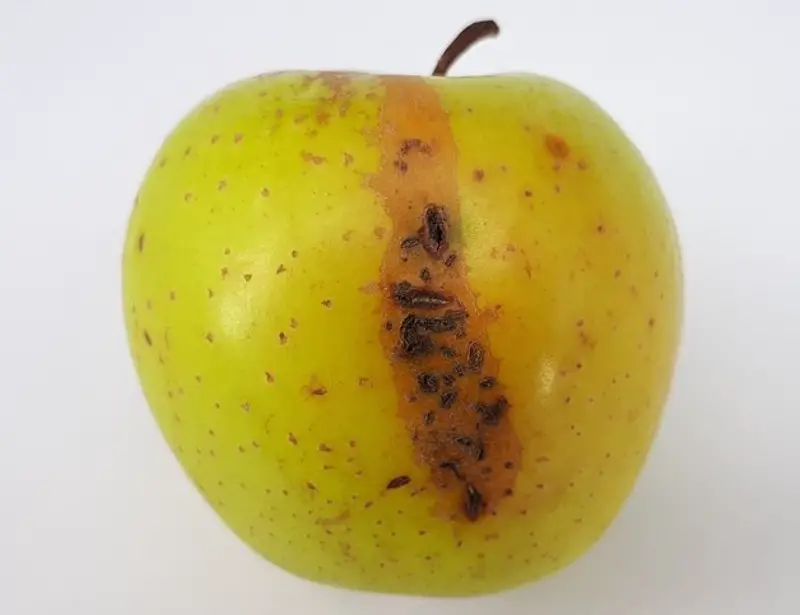

Apple scab is a fungal illness that may weaken a tree and spoil the fruits. The excellent news? By planting resistant varieties or utilizing fungicides, you’ll be able to keep away from this bitter destiny and save your apples and your tree.
There are lots of apple tree species which might be resistant to apple scab, together with Honeycrisp, Freedom, and William’s Satisfaction. Some well-liked cultivars that are prone to apple scab are McIntosh, Cortland, and Macoun.
Signs: Brown or olive inexperienced spots develop on apple tree leaves, which can curl and fall off. On the fruit, darkish inexperienced spots seem on its floor (later turning into darker, flaky, and even cracked). Contaminated fruit will often drop, and infections might restrict flower formation.
Causes: Spores launched from contaminated apple leaves which have remained on the bottom by winter. These spores then infect close by apple timber. Apple scab can even unfold from close by timber already contaminated. Frequent rains and extended leaf wetness allow extreme scab an infection situations.
Remedy: Rake up leaves and take away them from the orchard earlier than Might. Take away deserted apple timber inside 100 yards of your orchard. The University of Maine (UMaine) Cooperative Extension recommends making use of preventive sprays reminiscent of captan, sulfur, or different fungicides.
Season: In accordance to the UMaine Cooperative Extension, infections can happen as quickly as early Might when inexperienced tissue emerges from the bud. The illness continues to unfold all season with every rainfall.
Threat: Apple scab not often kills timber. Extreme instances might trigger full defoliation by early summer time. Repeated infections will weaken the tree, making it prone to different illnesses.
2. Sooty Blotch and Flyspeck
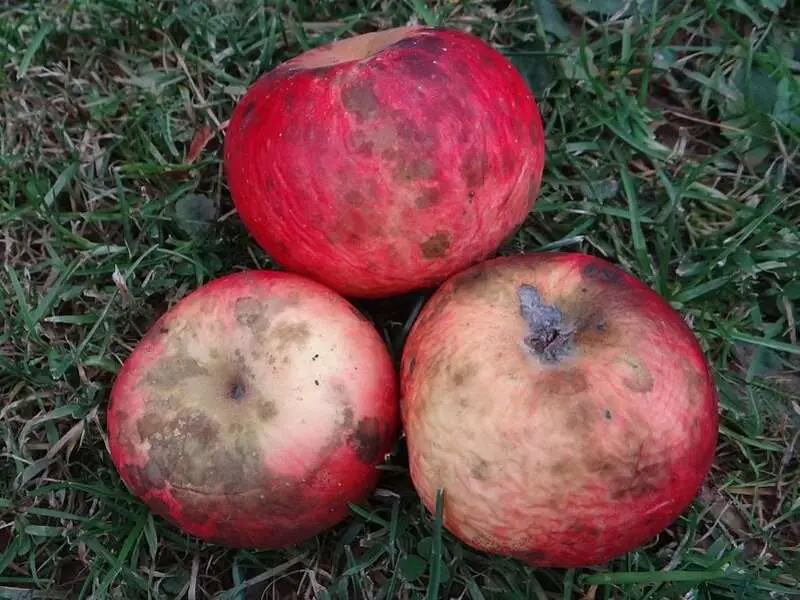

Flyspeck and sooty blotch are fungi that develop on the floor of apples. They trigger blemishes on the apple’s floor however don’t hurt it. They usually seem collectively and develop within the late summer time.
There aren’t any identified apple cultivars resistant to sooty blotch and flyspeck.
Signs: Flyspeck is a fungus that seems as round clusters of tiny, outlined black dots. Sooty blotch varieties irregular, olive-inexperienced blemishes across the apple’s floor. Seen signs take a month or extra to seem after an infection. Sooty blotch and flyspeck want situations with excessive humidity in unpruned, massive timber or timber with a lot of morning dew.
Causes: The fungi inflicting these two illnesses overwinter within the twigs of apple, pear, and woody crops. Spores of the sooty blotch and flyspeck fungus splash onto fruits throughout rainfall. The spores can also change into airborne and have an effect on close by fruits this manner.
Remedy: The UMaine Cooperative Extension recommends making use of a fungicide software in mid to late July, with a second software in August. Prune and skinny the apple timber to improve air circulation and dryness.
Season: Heat, humid climate situations lead to illness growth.
Threat: These two illnesses don’t trigger rots within the fruit. Affected apples are secure to eat.
3. Cedar-Apple Rust
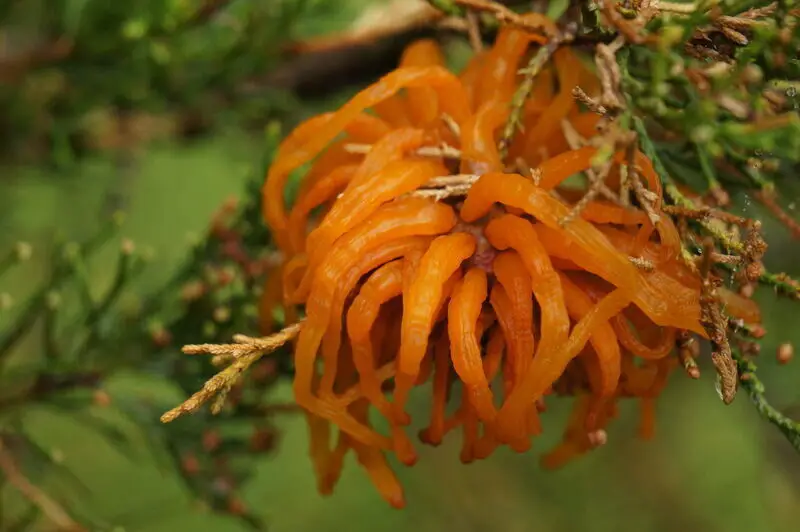

Cedar-apple rust is simple to spot with inform-story yellow or orange spots that develop on the leaves in early levels, then galls that type on department suggestions. The fungus is carried on the wind, shortly making it unfold.
Resistant apple cultivars embody Black Oxford, Enterprise, and William’s Satisfaction. Golden Scrumptious apple timber are fairly prone to cedar-apple rust.
Signs: Yellow or orange spots roughly 0.25 inch in diameter develop on the leaves. These colourful spots are vibrant on the higher floor of the leaf, and because the spots age, black dots type of their heart. Galls develop on department suggestions in early spring. These galls swell up to 2 inches in diameter and produce vivid orange, jelly-like tubes.
Causes: Cedar-apple rust happens when apple timber are grown shut to Japanese crimson cedar and different junipers. Apple timber, Japanese crimson cedar timber, and junipers unfold the illness to one another. The fungus overwinters in contaminated branches and galls on crimson cedar and juniper timber.
In spring, the galls produce the orange, gummy, fungal progress, which creates spores in moist situations. These spores are then carried by the wind to apple timber up to one mile away. Over the summer time, the an infection begins to develop.
Because the apple tree leaves develop the intense crimson spots on their higher facet, the undersides of the lesions develop small raised tubes that produce powdery, orange spores. These spores are then launched mid to late summer time to infect juniper and crimson cedar timber.
Remedy: To forestall the unfold of illness, the UMaine Cooperative Extension recommends making use of fungicides containing fenarimol or myclobutanil. Keep away from planting the host timber close to each other. Examine close by juniper and crimson cedar timber in late winter or early spring. Prune and take away galls earlier than the orange, gummy constructions type within the spring.
Season: The illness spreads to apple timber from late April to mid-June.
Threat: Cedar-apple rust shouldn’t trigger extreme harm to your tree’s well being.
4. Powdery Mildew
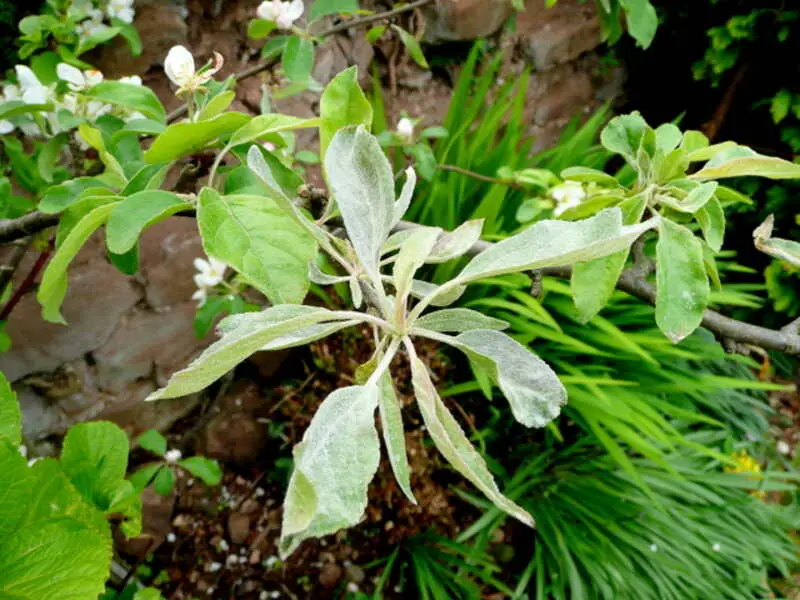

Powdery mildew is brought on by a fungus that hinders the apple blossoms’ manufacturing of fruit and stunts the apple tree’s progress. Probably the most noticeable symptom is a powdery white coating on the leaves.
Apple timber prone to powdery mildew are Jonathan, Bonza, Jonagold, Elstar, Pink Girl, Girl William, and Gala.
Signs: The fungus causes grey-white powdery patches to type on leaves. Leaves and shoots might flip brown in mid-summer time.
Causes: The fungus overwinters inside contaminated buds. As these buds open in spring, they change into lined with powdery spores. The wind carries the spores to infect new leaves, fruit, and shoots.
Remedy: Prune contaminated branches and twigs early within the season. If the illness is extreme, fungicides can be utilized for therapy.
Season: This illness prefers scorching, dry situations and begins to unfold when buds open within the spring.
Threat: Although it does stunt the tree’s progress and fruit manufacturing, powdery mildew won’t kill your tree.
Get the perfect tree care service at an inexpensive value
With LawnStarter
5. Hearth Blight
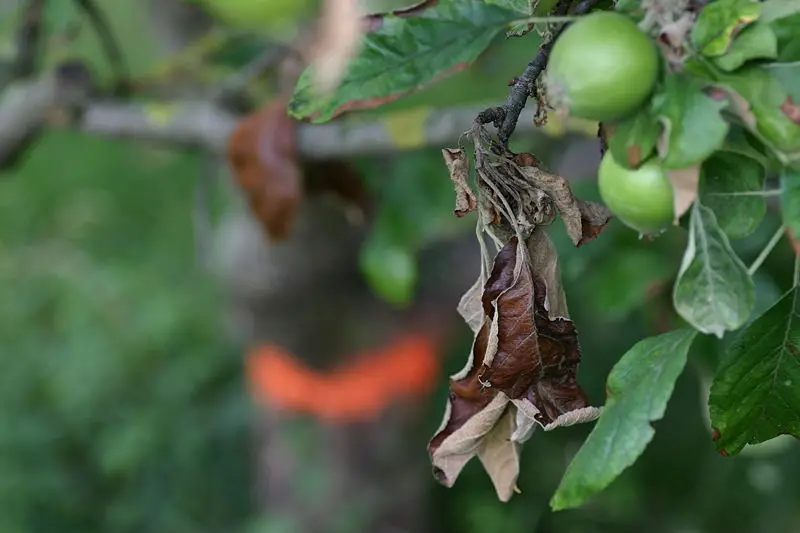

Hearth blight is bacterial illness that impacts apples and pears and is troublesome and costly to management. There isn’t any remedy for this illness, and it will possibly kill your apple tree, making prevention essential. It’s greatest to plant essentially the most tolerant cultivars potential.
Varieties reminiscent of Arkansas Black and Early McIntosh are reasonably resistant. On the different finish of the spectrum, cultivars reminiscent of Rome Magnificence and Braeburn are extremely prone.
Signs: Hearth blight will trigger contaminated flowers to flip black and die. The illness strikes alongside the department, killing twigs, and the leaves on affected branches start to wilt and blacken however stay connected to the timber.
Affected elements of the tree can embody blossoms, stems, leaves, and fruits, and your tree develops a fireplace-scorched look. The micro organism survive in cankers, which seem as sunken lesions on the tree.
Causes: The bacterium Erwinia amylovora causes fireplace blight. Throughout moist climate situations within the spring, you might discover a milky liquid oozing from contaminated areas. This liquid incorporates fireplace blight pathogens. Bugs and splashing rainfall can unfold this illness and infect different timber.
Remedy: Preventive controls embody choosing tolerant apple tree varieties and making use of bactericides and pesticides. Prune blackened twigs and branches with cankers utilizing sanitized instruments through the dormant season. You might unfold the illness when you prune through the rising season.
Destroy all contaminated prunings by burning or burying them. If fireplace blight has been extreme the earlier 12 months, the Clemson Cooperative Extension recommends one spray of a copper fungicide utilized instantly earlier than bloom.
Season: The primary signs of fireplace blight happen in early spring. It’s most lively when temperatures are above 60 levels Fahrenheit, and the climate is moist or humid.
Threat: This bacterial illness spreads quickly and can kill apple timber when situations are proper.
Professional Tip: For extra info on which styles of apple are most and least resistant to fireplace blight, take a look at the USDA Cooperative Extension web page on fireplace blight susceptibility.
6. Bitter Rot
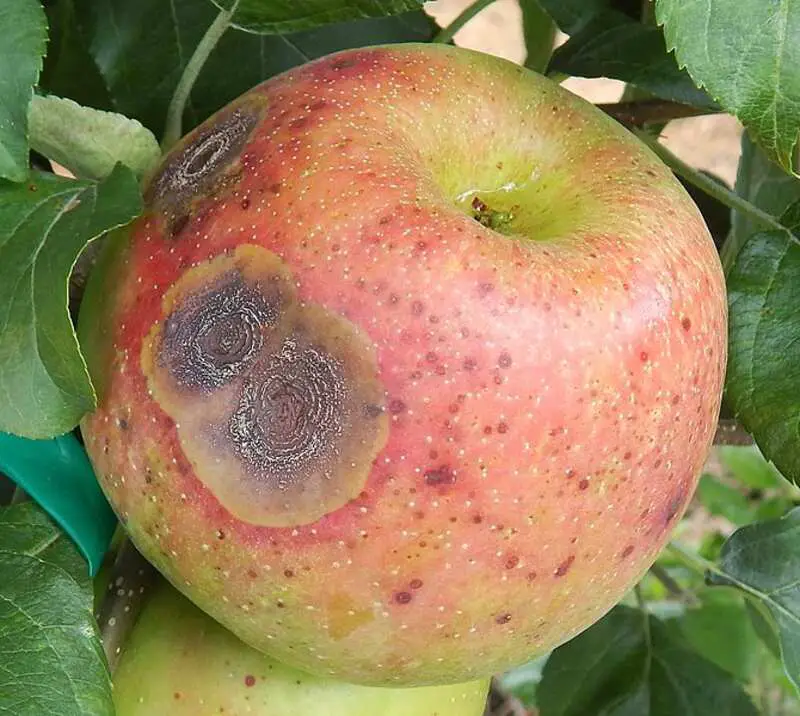

Bitter Rot is a fungus that causes decay in apples and pears. This illness overwinters in contaminated fruit and wooden and develops the following 12 months when the temps and humidity are excessive. Bitter rot is present in each state the place these fruits are grown.
Gentle-coloured apples, reminiscent of Empire, Honeycrisp, Mclntosh, Dawn, Paulared, and Jonagold are most prone to bitter rot.
Signs: Lesions with concentric rings lengthen to the core of the fruit. These lesions usually seem on the facet of the apple with essentially the most direct daylight. A bitter-smelling rot develops. Because the contaminated fruit ripens, it continues to decay and dry up.
Causes: Bitter rot doesn’t want the fruit to have a wound to set up an infection. The fungus can infect the fruit by direct penetration of the pores and skin. These concentric rings start to ooze a gelatinous, pink substance made up of spores. This mass of spores is then unfold by rainfall to different fruit.
Remedy: Take away diseased fruit, useless wooden, and any cankers fashioned within the wooden tissue. Penn State Extension suggests making use of fungicides each 10 to 14 days by harvest and extra continuously underneath bitter rot’s most popular situations. The Extension recommends merchandise referred to as captan and ziram as protecting management strategies when mixed with one other fungicide.
Season: Bitter rot happens in the summertime when situations are heat and moist.
Threat: Bitter rot could cause extreme harm to your harvest.
7. Black Rot
Black rot is a fungus that causes spots on leaves in a “frogeye” sample, in addition to rotten fruit and cankers on branches. Sanitation, correct pruning, and proactively sustaining tree well being will assist scale back the unfold of this illness.
Empire and Cortland are extra prone than different cultivars, although susceptibility varies little all through apple tree varieties.
Signs: Contaminated leaves type spots thought to appear like frog eyes with reddish edges and tan middles. Massive, brown, rotten spots develop on the apple, mostly on the blossom finish. Though the floor of the apple is brown, the flesh of the apple stays agency. Fruits shrivel up and dry out whereas remaining connected to the tree.
Causes: The fungus can have an effect on trunks, leaves, branches, and fruits. Pycnidia, spore-producing constructions, develop on contaminated fruit and seem as small, black spots. Rainfall and wind carry the spores to different prone areas. The fungus infects leaves, wooden, and fruit by openings or wounds. Timber are most weak to black rot when contaminated with fireplace blight.
Remedy: Take away useless or diseased branches and dried fruits. Burn or bury all contaminated plant supplies. Should you lower down any tree, take away the stump to make sure the spores don’t unfold.
Fungicides are usually not used to handle black rot. Use captan and sulfur merchandise labeled for black rot management provided that wanted. Carry out preventive measures for fireplace blight to guarantee your timber don’t change into extra prone to black rot.
Threat: In accordance to the University of Minnesota Extension, leaf spots should not have a extreme impact in your tree’s well being except many leaves flip yellow and fall off.
8. White Rot
Botryosphaeria dothidea is known as “white rot” or “Bot Rot.” It’s a fungus that impacts apple, crabapple, chestnut, and pear timber, in addition to grapes. Sustaining a wholesome tree, correct pruning (and removing of fallen branches), and fungicides are frequent management measures.
Golden Scrumptious, Empire, and Jersey Mac are extra affected by white rot than different apple tree cultivars.
Signs: Bot rot is brought on by a extreme fungal pathogen. New infections on twigs and limbs change into evident in early summer time showing as small spots or blisters.
The white rot fungus infects an apple tree’s wooden and fruit, however not the leaves. Apples start to develop a mushy rot, not like bitter rot and black rot, which type agency rots. Sunken, watery lesions type on the floor, and crimson-skinned apples start to fade in coloration. When white rot develops underneath cool situations, the rotten space can seem as agency as black rot.
Causes: An infection and canker progress improve underneath drought, stress, winter damage, or fireplace blight. The cankers change into indistinguishable from black rot cankers.
Black pycnidia, the spore-producing constructions, develop on the floor of cankers. Throughout moist durations, spores ooze out of the fruiting constructions and are unfold by rainfall. The an infection then spreads by getting into the injuries of weak timber.
Remedy: Take away shriveled, rotten apples and prune deadwood. Carry out preventive measures to make sure the tree doesn’t expertise stress. To lower stress, take away fireplace-blighted wooden, and water timber throughout drought.
Season: This can be a extreme and frequent late-season illness in apple timber.
Threat: If white rot has infested your tree, you might expertise a 50% loss in fruit.
Integrated pest control strategies for apple tree health
When it comes to preserving the health of your apple bushes, incorporated pest control (IPM) strategies play a vital position. IPM is a holistic technique that focuses on preventing and handling pests and diseases while minimizing using harmful chemicals. By enforcing powerful IPM techniques, you may make certain the long-term fitness and productiveness of your apple timber.
One of the important thing additives of IPM is normal monitoring. By carefully looking at your timber, you can identify any signs of pest infestation or ailment early on. This allows you to take instantaneous motion and prevent the trouble from spreading. Inspect the leaves, branches, and fruits for any abnormalities, along with discoloration, spots, or unusual growth.
Another critical factor of IPM is promoting a wholesome growing environment in your apple timber. This consists of proper pruning and schooling techniques, good enough irrigation, and suitable fertilization. Well-maintained bushes are much less vulnerable to pests and illnesses, as they have more potent immune structures and might better resist attacks.
Cultural practices also play a massive function in IPM. For instance, practising correct sanitation via disposing of fallen leaves and end result can help remove ability breeding grounds for pests and diseases. Additionally, rotating crops and planting companion flora that repel pests can create a much less favorable surroundings for them to thrive.
When it comes to pest manipulate, IPM encourages the usage of herbal predators and useful bugs. These organisms can assist keep pest populations in test without the need for chemical interventions. Introducing ladybugs, lacewings, or predatory mites on your apple orchard can offer powerful biological control.
However, in certain cases, targeted pesticide programs can be vital to control severe infestations or diseases. In such instances, it’s far vital to pick the least toxic and most targeted insecticides to be had. Follow the commands cautiously and practice them sparingly to reduce any capability poor affects on the environment and useful organisms.
Maintaining ordinary tree health and preventing future illnesses
Maintaining the general fitness of your apple bushes is crucial in preventing future diseases and making sure their sturdiness. When it comes to ailment prevention, a proactive technique is key.
First and foremost, right pruning is crucial. Regularly investigate your trees for any lifeless, damaged, or diseased branches and directly eliminate them. Pruning no longer best improves air movement and daylight penetration, however it additionally reduces the chance of sickness unfold. Remember to disinfect your pruning tools among cuts to save you go-contamination.
Another essential thing of retaining tree fitness is proper nutrition. Ensure your apple timber are receiving the important nutrients with the aid of engaging in soil exams and offering suitable fertilization. A properly-balanced fertilizer can sell healthful boom and improve the tree’s herbal protection mechanisms against sicknesses.
Regularly display and manipulate pests inside the orchard. Pests can weaken the timber and cause them to extra at risk of diseases. Implement included pest management techniques, which include the use of useful bugs, traps, or organic pesticides, to limit the damage as a result of pests.
Additionally, training desirable sanitation measures can drastically make contributions to stopping diseases. Remove fallen leaves, end result, and different plant debris from across the trees, as they are able to harbor pathogens. This reduces the possibilities of diseases overwintering and reoccurring in the following seasons.
Lastly, consider imposing cultural practices that promote tree health. Adequate irrigation, proper spacing between timber, and providing sufficient daylight are all elements that make a contribution to the overall vitality of your apple trees. Healthy bushes are less probable to succumb to diseases and are higher prepared to combat off infections.
FAQ
Why are my Apple Tree Leaves Curling?
You could be paying an excessive amount of consideration to your tree or not sufficient. An excessive amount of and too little water could cause issues. Vitamins might be washed from the soil when you water an excessive amount of, for instance. Additionally, pests or illnesses like to assault weak timber. Different potential causes embody fungal illnesses, extreme fertilizer, or transplant shock.
Ought to I Reduce my Diseased Apple Tree Down?
Not essentially. Many tree illnesses might be stopped, slowed, and rectified with remedies. A certified arborist could make the decision for you when you’re undecided.
What’s the First Signal of Apple Tree Illness?
In some instances, spots or discoloration on the leaves and fruits or sunken areas on branches (cankers) are seen. Different early signs of illness embody leaf curling and a white, powdery substance in your leaves. Should you act shortly, you might have the ability to cease or gradual the unfold of illness.
